Cape to Cairo Journey:
Pages to Explore:
Blog Catagories:
Photo of the day








Home | About Us | Safaris & Photographic Trips | Blog | Contact Us | Sitemap | Disclaimer
The Essence of the Journey!
We would like to do this trip to experience new cultures.
We would like to understand what makes African people pure.
What are their spiritual beliefs, understandings?
How does the spiritual world we know exist to them?
What can we learn from them?

Mar 23 12
Talking Rhinos from Botswana into Zim
Leaving Botswana talking Rhinos
In Kasane I met Mark Marx. In fact I was getting some supplies at Kasane Spar when he approached me, having seen the RRP (Rhino Rescue Project) and C2C signs on the car.  He is an honorary ranger of the Chobe National Park and as volunteers they go about looking after natural resources in the area.  I mentioned that we would be in Chobe for a few days and that if he would like to arrange a forum, I would be happy to chat to them about the RRP.  Impressively Mark arranged a forum of 8 including the head of anti-poaching in Chobe, regional vet and others for our discussion.  We met in the conference area at the Biodiversity Centre.
Chobe has relocated their rhino to a place where they are placed under guard 24/7, as the threat by poaching is too severe.  Upper Chobe River system has a public tar road that runs over 100km to the south of the park.  As we know, this is a serious threat to wildlife security.  It is a huge pity, as this area is incredibly fertile and really calls out for rhino roaming free.  The Chobe River is well supported by tourists and would be further so with the completion of the big 5.
The discussion lasted almost two hours, and was concluded with a discussion with the regional head of research of conservation in the area that fortunately was able to meet at short notice.  The RRP was well received and the point was made that the Prime Minister had identified rhino conservation as a priority in Botswana.  This would be something she was very excited to endorse for government approval.  A positive morning of discussion left us all filled with expectation that the RRP could be adopted as policy by Botswana Wildlife.
Hwange National Park 
Stop, close your eyes.  Reach out, feel for magic.  What is out there…?
Trees, tall ones, wise ones.  They have seen so much, so many stories to tell.  But now they are sad.  Another season has passed.  There has been little growth, little change.  Has there been enough nourishment and growth to get through another period of cold, stagnation.  Animals too are battling to hold on.  They run, almost blindly at times, in constant fear.  The energies are upset, upside down.
Perhaps I was young and na√Įve when I first visited Zimbabwe.¬†
I was full of young love, and the world was opening itself to me, for the first time.  Oh I long for those days for you Zimbabwe.  The regime was 20 years younger then.  There were positive feelings and emotions around then, optimism.  Where are they now?
We drove through the Matetsi area coming from Kazangulu to get to Robin’s camp.  The trees in the area are unique, and we were chuffed to getting into sharpening our tree identification.  This area is mainly a safari area, where pre-arranged animals are hunted through head office at Harare.  This was clearly evident as the animals were on edge and ran off quickly.
H.G. Robins, upon his death, donated his farm of 25 000 acres to the then Southern Rhodesian Government.  We were the only visitors at Robins in the last week.  Previously they had been visited by a couple from the Cape that had stayed for one night.  They were desperate for visitors, and I felt for the lady at reception that was stationed from 06h00 to 18h00 daily, in the hope of a visitor.  The camp is very run down, but the friendly staff make up for it.  There is a display housed at Robin’s look-out tower, which is a tribute to Herbert George Robins (1867-1939). He was a fellow of more than a dozen societies, and being an eccentric chap, one would imagine him frowning at the goings-on, hands on hips and a sad shake of the head.
Robins has the highest density of lions in the park, and one can hear them from late afternoon to early morning.  After staying two nights we drove 130km through Sinamatella, which is set on a picturesque ridge overlooking an attractive waterhole.  This area is predominantly Mopani woodland.  Main Camp, according to recent articles, had been done up and is 130km from Robins on a mostly good road.  As the name suggests, this is the busiest of the Hwange camps, and with the open woodland, is the easiest place to see wildlife. 
The restaurant at Main camp is called the Waterbuck’s Head.  The meal was nourishing, it took it’s time, and the portions were large.  We had opted to change the routine and have a meal cooked by another, as opposed to ourselves.  We succeeded in this.  The staff of the restaurant had left the chip fryer on overnight, and even though it was now 24 hours later, and we were sitting in an open air dining room, the stench was nauseating.  It was everywhere from the air to the napkins.  In fact there was a table of four English guests next to us that lasted about 30 minutes.  With their food taking its time to arrive, they stood up and left, hungry.
On the way out from dinner I was greeted by the table next door.¬† There was a large figure, a local by the name of Bongani.¬† His fingers were shiny with oil; he had rolled together some maize, and was dipping this African ‚Äėdumpling‚Äô into his sesheba.
‚ÄúI see that you have some rhino stickers on your car‚ÄĚ he grunted.
¬†‚ÄúYes, I‚Äôm promoting a new technology in rhino anti-poaching,‚ÄĚ I replied.¬† ‚ÄúWe inject an ectoparasiticide into the horn, and this makes it unsuitable for human consumption,‚ÄĚ I added.
¬†‚ÄúWell, I am Mr. Rhino in Hwange,‚ÄĚ he gloated without a smile. ‚ÄúWe should meet.¬† Are you leaving tomorrow?‚ÄĚ
‚ÄúNo, we can meet. How about 12h00, here at the restaurant?‚ÄĚ
‚ÄúPerfect,‚ÄĚ he replied.¬†
‚ÄúSee you then,‚ÄĚ we agreed.
Bongani had two other folk at the table, and I was walking out with my family, with us having eaten, so the conversation went no further.
 
The following morning we were up at 05h15, and on our game drive by 06h00.  There was a fine misty rain falling, which stopped, at times being substituted by a thick dew.  This Tolkein bloke was following us around with his enchanting mornings but the game eluded us.  We saw some impala, waterbuck and zebra on the river road.  We were thrilled to bump into Brent Stapelkamp from the Hwange Lion Research program.  We had been watching him from a distance.  We were watching some crowned crane and he politely stopped some way back from us, climbed on top of his Landrover, and waved his antennae around. 
He could not pick up DSTV.  Apparently the female he had collared recently was nowhere to be found.  He had been working in Hwange for 6 years.  I mentioned that we had been on the road, promoting RRP technology.  I asked what contact he had had with rhinos in the park.  Brent mentioned that when he first arrived, he would have 3-4 sightings a day of rhino.  Now, he had not seen a rhino in 8 months.  He mentioned that there was rumour of a female and a calf in the area, but he had not seen them. 
‚ÄúThey are finished in this park ‚Ķ‚ÄĚ he commented.
Like a New Zealand prop forward running at full tilt, this comment hit me.  Phew…  What do you say after that?
We were back at 11h30, where Nicolai made us some bacon and scrambled eggs for breakfast.¬† They were delicious, and then off I went to meet with Bongani.¬† 12h00, 12h05, 12h12 ‚Äď was he going to show?¬† It was a Sunday, although, he had called for the meeting after all.¬† With the decline in rhino population evident, Mr Rhino was clearly not succeeding in his efforts to protect the rhino.¬† Was there a possibility that he was in on, or aware of the poaching?
I engaged with the waiter and asked if it possible to meet the chef?  Lazarus (reluctantly at first) approached, wiping his hands saying that he was busy cleaning, although he did manage a smile.  I mentioned that we had dinner at his place the night before, and that I was appreciative of the logistical challenges with which he was faced. 
I had a flash ‚Äď Ramsay‚Äôs kitchen nightmares.¬† We discussed the difficulties of not knowing how many people would be coming through for dinner, what they would be eating, etc.¬† I had witnessed firsthand, the ghostliness that Hwange was going through.¬† But this was a first step for them starting over.¬† I suggested that instead of providing an a la carte menu, he should consider a set menu, 2 starters, 2 mains and a desert.¬† He could then focus on the quality of food as opposed to trying to satisfy everyone with quantity of, mediocre product.¬† I got a huge, appreciative Zimbabwean smile.¬† There was someone who felt his pain.¬† His eyes sparkled, he would be suggesting this to his manager, tomorrow.¬† It was almost 13h00, no Mr. Rhino.
That evening, we went out to the Nyamandlovu platform.  We saw two lionesses asleep on a termite mound, about 100m from the waterhole.  They were re-charging before the evening escapades.  We enjoyed drinks as 14 giraffe came down to the water to drink oblivious to any threat.  There were 2 black-backed jackal, 2 huge crocodiles, 4 hippo, zebra and a lone wildebeest too.  This was the best game viewing we had the last 4 days in Hwange.  On our way out the following morning we returned to say goodbye.  The lionesses had moved about 200m and been joined by an adult male.  They had not made a kill.  With herbivores on edge in Hwange, I felt uncertain of the park’s future.  Was this from poachers, hunters or lions?  Are friendly staff enough to attract tourists to the park?  I would recommend you pay her a visit, but rather camp, and bring whatever you need.
At Hwange one gets the feeling that the Marabou Stork is the national bird of Zimbabwe, whereas it should perhaps be the Village Weaver.




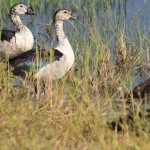
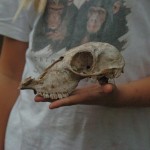
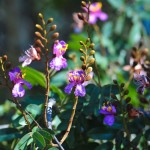

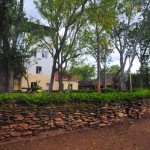

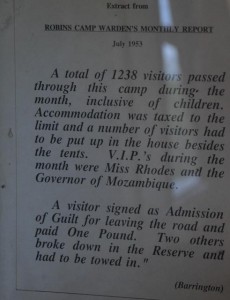







Hi, I have been faithfully following your blog. It has been quite an adventure so far and Ill be accompanying you “virtually” all the way. Have fun and keep the stories and facts coming!
Hi Cousin, sorry to only be getting to this now, but we’re in Zambia now and using satelite communication, it is very expensive. I’m at a mechanic getting some work done on the car and have been able to use his internet connection. I know it probably sounds backward to you guys, but internet access is still a luxury out here. Stacks of love & thanks for the support. Marcelo